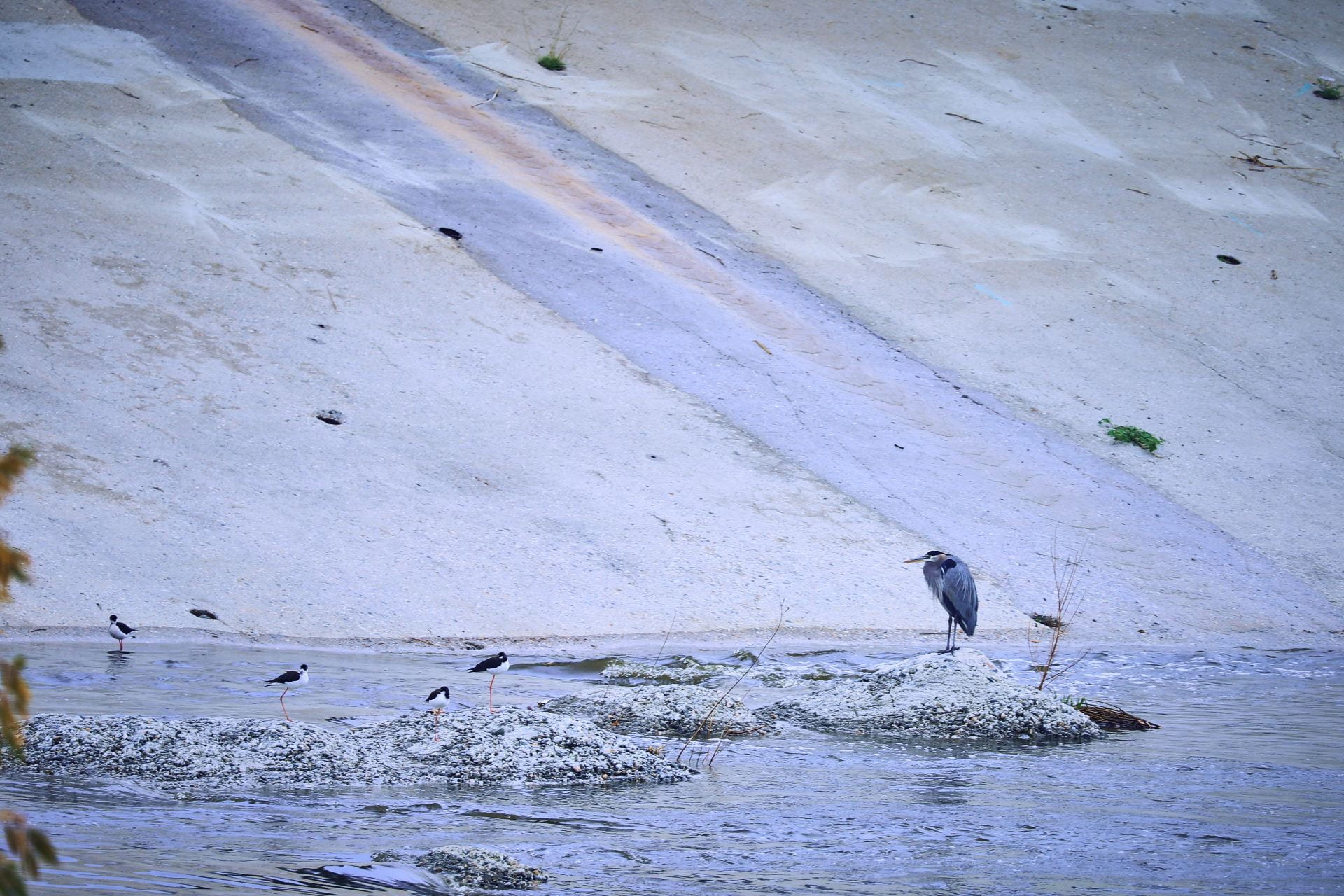
by Lauren Kelly
Once, the Los Angeles River ran a wild course across the LA Basin. During California’s long dry seasons, the river would disappear from the surface into the porous ground, only to return in the form of dramatic floods and surges during wet winters. Indigenous peoples, such as the Kizh-Gabrieleño, coexisted with the LA River for thousands of years. Native groups established a village-state named Yaangna at the section of river that runs above ground year-round, known today as the Glendale Narrows. They used the river water to cultivate a forest of oak trees, along with pruning, weeding, prescribed burning, and other methods of vegetation management. These river ecologies were transformed by Spanish settlers, who violently displaced Indigenous communities. Mexico gained control of the LA River in 1821, but lost it when the US took over through a war of conquest in 1848.
Over the last century, the city of Los Angeles dramatically transformed the river itself. Developers pushed neighborhoods further into the river’s historic floodplain. The urban sprawl edged right up to the banks of the river. These precarious development plans exposed urban residents to the river’s periodic floods, killing people and damaging buildings. To ease these issues, city officials charged the U.S. Army Corps of Engineers with flood control; in turn, the Army Corps of Engineers encased the river in concrete. This long process was completed in 1970, and essentially transformed the once-wending river into a concrete storm drain, which – along with the network of concrete gutters throughout the city – whisked stormwater straight to the ocean. This system prevents flooding, but it also precludes rainwater capture to supplement the city’s water supply.
Despite the unsightly nature of the river’s concrete conduit, the LA River has become an iconic landmark in the minds of Angelenos over the last several decades. Indeed, it developed a cinematic mystique when several films used its channel as a backdrop, such as Point Blank (1967) and Grease (1978). The river has also grown to symbolize a multitude of different visions for LA’s future. In the 1980s, environmental movements started advocating for returning the LA River to a more natural state. Environmental justice groups protested the disproportionate burden of pollution and lack of green space shouldered by poor communities of color living near the LA River. Other Angelenos view the LA River’s clashing aesthetic of nature and concrete as an ideal place for creating art, and still others see it as a site for recreation. In 1996, LA County released its first Master Plan for revitalizing the river, a plan that stakeholders have continued to debate for the last two decades. LA passed an updated Master Plan in 2022, although many community groups withdrew their support when they learned that the plan does not adequately address social and ecological equity issues. Many Indigenous peoples in LA also argue that the county’s planning process has deprioritized their concerns about protecting cultural resources. The question of where to go from here remains unsolved, and we look forward to diving into these themes with our panelists.
Recommended Reading
Academic publications:
- Mike Davis, Ecology of Fear: Los Angeles and the Imagination of Disaster (New York: Metropolitan Books, 1998).
- Blake Gumprecht, “Who Killed the Los Angeles River?” in Land of Sunshine: An Environmental History of Metropolitan Los Angeles, edited by William Deverell and Greg Hise (Pittsburgh: University of Pittsburgh Press, 2005): 115–34. https://doi.org/10.2307/j.ctt5hjnm5.14.
- Jenny Price, “Remaking American Environmentalism: On the Banks of the L.A. River,” Environmental History 13, no. 3 (July 2008): 536–55. http://www.jstor.org/stable/25473266.
- William Deverell and Tom Sitton, Water and Los Angeles: A Tale of Three Rivers, 1900-1941 (Oakland: University of California Press, 2017). https://www.jstor.org/stable/10.1525/j.ctt1kc6k05.5.
- Vittoria Di Palma and Alexander Robinson, “Willful Waters,” Places Journal (May 2018). https://doi.org/10.22269/180508.
- Philip J. Ethington, Beau MacDonald, Gary Stein, William Deverell, and Travis Longcore, “Historical Ecology of the Los Angeles River Watershed and Environs: Infrastructure for a Comprehensive Analysis,” Report to the John Randolph Haynes and Dora Haynes Foundation, June 15, 2020, https://lalandscapehistory.files.wordpress.com/2020/08/ethingtonhaynesfinalreport.pdf
- Wendy Katagi, Nate Butler, Anthony Keith, Shelly Backlar, and Bruce Orr, “Ecological restoration of the Los Angeles River provides natural and human benefits as part of a virtuous socioecological cycle,” Frontiers in Ecological and Evolution 10, no. 25 (August 2022). https://doi.org/10.3389/fevo.2022.932550.
- Alexis M. Mychajliw, Elizabeth R. Ellwood, Peter S. Alagona, R. Scott Anderson, Mairin A. Balisi, Eric Biber, Justin L. Brown, Jessie George, Austin J.W. Hendy, Lila Higgins, Courtney A. Hofman, Ashley Leger, Miguel A. Ordeñana, Gregory B. Pauly, Breanna J. Putman, John M. Randall, Seth P.D. Riley, Allison J. Shultz, M. Allison Stegner, Thomas A. Wake, and Emily L. Lindsey, “Lessons for conservation from beneath the pavement,” Conservation Biology 36, no. 6 (September 2022). https://doi.org/10.1111/cobi.13983.
Other publications:
- Robert García and Tim Mok, “Whitewashing the Los Angeles River? Gente-Fication Not Gentrification,” Parks & Recreation 9, (2017): 50-52. http://libproxy.usc.edu/login?url=https://www.proquest.com/magazines/whitewashing-los-angeles-river-gente-fication-not/docview/1939213988/se-2.
- Michael Lozano, “Indigenous Voices Missing in Los Angeles River Revitalization Plans” LENS Magazine, September 23, 2018. https://lensmagazine.org/indigenous-voices-missing-in-la-river-revitalization-plans-c8b94a578927.
- Robert Bracamontes and Robert García, “Native Americans, Urban Waters, and Civic Engagement: The L.A. River,” https://cdi.anacostia.si.edu/wp-content/blogs.dir/7/files/2014/10/Native-Americans-Urban-Waters-and-Civic-Engagement-The-L.A.-River.pdf.
- C.J. Schexnayder, “The Reimagining of the Los Angeles River” Engineering News-Record 289, no. 1 (July 2022): 40-44. http://libproxy.usc.edu/login?url=https://www.proquest.com/trade-journals/reimagining-los-angeles-river/docview/2706463920/se-2.
- Michael Kimmelman, “Remaking the river that made LA” New York Times, November 10, 2022. https://www.nytimes.com/interactive/2022/11/10/magazine/la-river-redesign.html
- ** Note: this article has an audio reading embedded in the webpage if you would prefer to listen to it.
“LA River Master Plan,” County of Los Angeles, 2023. https://dpw.lacounty.gov/wp/larivermasterplan/

